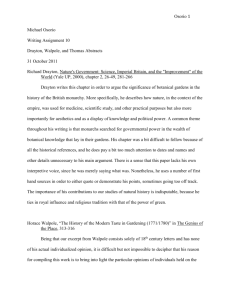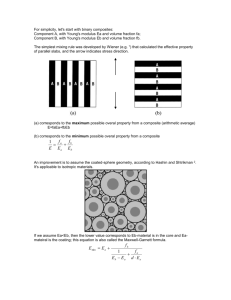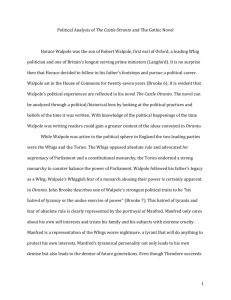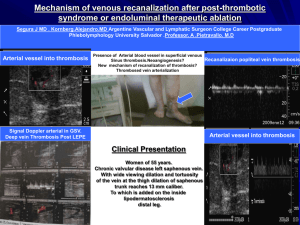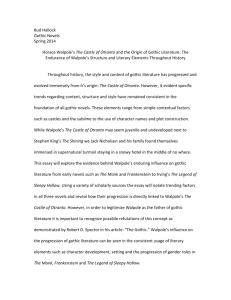WALPOLE Gary Frederick
advertisement
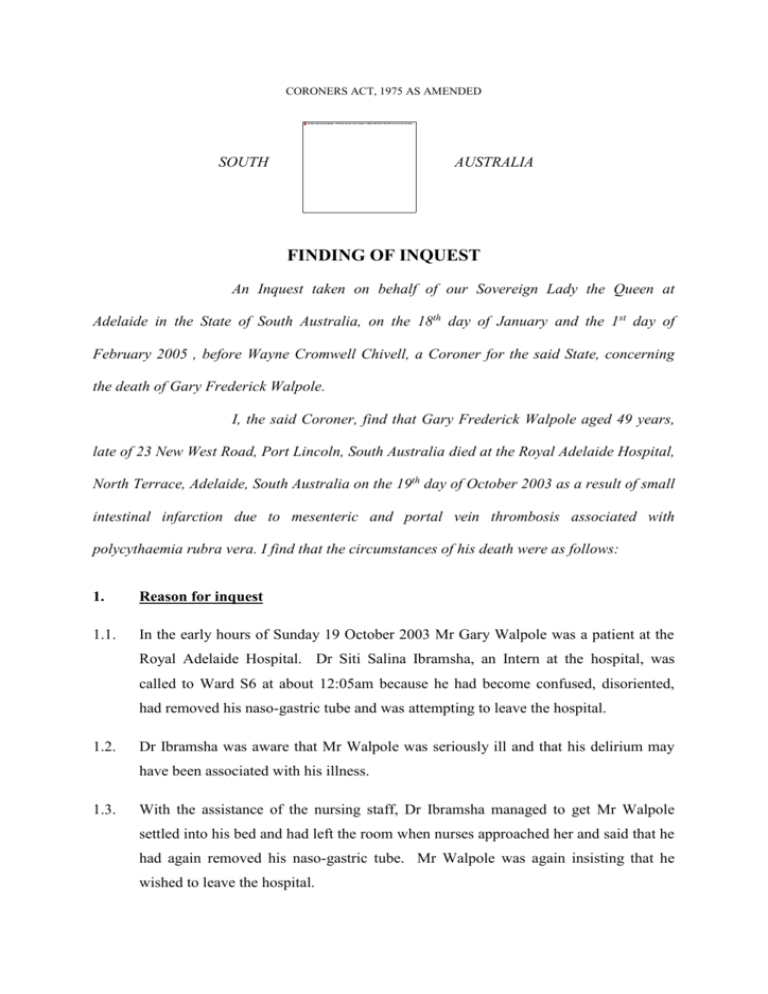
CORONERS ACT, 1975 AS AMENDED SOUTH AUSTRALIA FINDING OF INQUEST An Inquest taken on behalf of our Sovereign Lady the Queen at Adelaide in the State of South Australia, on the 18th day of January and the 1st day of February 2005 , before Wayne Cromwell Chivell, a Coroner for the said State, concerning the death of Gary Frederick Walpole. I, the said Coroner, find that Gary Frederick Walpole aged 49 years, late of 23 New West Road, Port Lincoln, South Australia died at the Royal Adelaide Hospital, North Terrace, Adelaide, South Australia on the 19th day of October 2003 as a result of small intestinal infarction due to mesenteric and portal vein thrombosis associated with polycythaemia rubra vera. I find that the circumstances of his death were as follows: 1. Reason for inquest 1.1. In the early hours of Sunday 19 October 2003 Mr Gary Walpole was a patient at the Royal Adelaide Hospital. Dr Siti Salina Ibramsha, an Intern at the hospital, was called to Ward S6 at about 12:05am because he had become confused, disoriented, had removed his naso-gastric tube and was attempting to leave the hospital. 1.2. Dr Ibramsha was aware that Mr Walpole was seriously ill and that his delirium may have been associated with his illness. 1.3. With the assistance of the nursing staff, Dr Ibramsha managed to get Mr Walpole settled into his bed and had left the room when nurses approached her and said that he had again removed his naso-gastric tube. Mr Walpole was again insisting that he wished to leave the hospital. 2 1.4. Being satisfied that Mr Walpole was suffering from a mental illness that required immediate treatment, that treatment was available at the Royal Adelaide Hospital, and that he should be detained at the hospital in the interests of his health and safety, Dr Ibramsha made an order pursuant to Section 12(1) of the Mental Health Act 1993 for his detention at the hospital. The order is dated 19 October 2003 at 0030 hours. 1.5. Mr Walpole persisted in his attempts to leave, and the staff were so concerned for his safety (particularly if he suffered another major haemorrhage), that a ‘restraint team’ was called and Mr Walpole was shackled to the bed (Exhibit C6a, p3). 1.6. Pursuant to the above section, the order has effect for 24 hours. Mr Walpole died later that morning, at around 7am. 1.7. Accordingly, Mr Walpole was ‘detained in custody pursuant to an Act or law of the State’ within the meaning of Section 12(1)(da) of the Coroners Act 1975, and an Inquest into his death was therefore mandatory by virtue of Section 14(1a) of the said Act. 2. Background 2.1. Mr Walpole was a school teacher who lived with his family at Port Lincoln. He had been a patient of Dr Kishor Mistry, General Practitioner, since 1986. Dr Mistry described him as ‘generally a fit and well person and from his medical records I can say that he was an infrequent visitor to the surgery’ (Exhibit C7a, p1). 2.2. On 24 April 2003, Mr Walpole attended upon Dr Mistry complaining of a swelling in his abdomen. Dr Mistry commenced a series of tests and referred him to Dr Rufus McLeay, a Physician and Endoscopist. 2.3. Dr McLeay saw him on 29 May 2003. Dr McLeay carried out some further tests but was unable to clearly diagnose his condition. He then referred Mr Walpole to Professor Tim Hughes, a Haematologist at the Royal Adelaide Hospital. Professor Hughes conducted chromosomal studies and a bone marrow biopsy. He concluded that Mr Walpole had developed polycythaemia rubra vera and suggested that Mr Walpole undergo regular venesection of 500mls of blood fortnightly. A venesection involves the opening of a vein to release blood. 3 2.4. Polycythaemia rubra vera was described by Dr John Gilbert, the Forensic Pathologist who performed the post-mortem examination of Mr Walpole’s body. It is the uncontrolled proliferation of cells in the bone marrow leading to an increase in the production of red cells, white cells, platelets and total blood volume. The condition leads to hypertension, with associated headaches, dizziness and gastrointestinal symptoms, and the blood is also inclined to clot more readily. This increased clotting, when combined with the proliferation of red cells, and the more viscous nature of the blood, can lead to thrombosis in various areas of the body including in the deep veins of the legs, and in the blood vessels associated with the heart, the brain, the liver, and the small and large bowel. 2.5. Dr Gilbert told me that in some cases, patients can survive for as long as ten years with regular venesection (T12). Unfortunately, in other cases such as in Mr Walpole’s case, death can occur at a much earlier stage. It would appear that the progress of the disease is unpredictable. 2.6. Following Mr Walpole’s presentation at the Institute of Medical and Veterinary Science laboratory at Port Lincoln on 13 October 2003 for his regular venesection, it was noted that his haemoglobin level had dropped from its previous reading on 15 September of 166 g/L (grams per litre) to 102g/L. 2.7. On 14 October 2003 Mr Walpole suffered a fainting episode while on his morning walk. He was taken to the Casualty section of the Port Lincoln Hopsital where the Casualty doctor ordered a blood picture, and this disclosed that his haemoglobin had dropped further to 84g/L, indicating possible blood loss. Dr McLeay was notified and he admitted Mr Walpole to hospital. Mr Walpole complained that he had been suffering abdominal and back pain for several weeks and melaena (blood in the bowel motions) for the previous three days. At about 2pm, Mr Walpole vomitted blood. Dr McLeay performed an urgent endoscopy which revealed large oesophageal varices, and a large amount of blood and blood clot in the stomach. Dr McLeay arranged for Mr Walpole to be transferred to Adelaide as a matter of urgency. 2.8. Mr Walpole was admitted to the Royal Adelaide Hospital under the care of Dr David Hetzel, a Consultant Gastroenterologist. An urgent endoscopy was performed which confirmed bleeding oesophageal varices and large gastric varices (Dr Gilbert told me 4 that these varicose veins were the consequence of hypertension, associated with Mr Walpole’s condition). 2.9. The varices were banded and Mr Walpole’s condition improved although he continued to require blood transfusions. 2.10. An abdominal CT scan on Thursday 16 October 2003 confirmed the clinical diagnosis of portal vein thrombosis (blood clot) with additional thrombosis of the splenic vein and superior mesenteric vein. Because there was so much blood clot in the veins, surgery, whereby blood draining from the small bowel via the portal vein could bypass the liver, was ruled out. 2.11. On Friday 17 October 2003 Mr Walpole collapsed with a sudden fall in blood pressure (hypotension) and a further emergency endoscopy was performed which showed massive intragastric bleeding from a varicose vein in the fundus (that part of the stomach above the cardiac notch). This was treated by injecting tissue glue through the endoscope. This appeared to be effective. 2.12. On 18 October 2003, Mr Walpole continued to suffer abdominal distention. A nasogastric tube was inserted to try and ease his discomfort but was not productive. Dr Hetzel commented: 'At this point, the bleeding appeared to have been, at least temporarily, controlled but his condition remained serious. Throughout Gary’s treatment, his condition gave rise to serious concern for his life. He had been given many units of blood and plasma expanders as documented in his clinical record. As a result, I had a long talk with his wife in regards to the seriousness of his condition.' (Exhibit C4a, p3) 2.13. During the evening of Saturday 18 October 2003, Mr Walpole’s restlessness and agitation became apparent, as I have already discussed. Following the detention order, Mr Walpole received one to one nursing from an Enrolled Nurse, who remained with him throughout the night. At about 5:30am, Registered Nurse Christine Walladge checked him and found him ‘calm and settled’. She asked him how he was and he indicated that he was ‘okay’ (Exhibit C6a, p4). 2.14. At 6:15am RN Walladge checked Mr Walpole again and found him pale and unresponsive. Cardio-pulmonary resuscitation was commenced and an emergency was called. The ‘Arrest Team’ arrived within a minute or so and took over the 5 resuscitation efforts and continued to attempt to resuscitate Mr Walpole for 15 to 20 minutes. 2.15. Dr Stephen Guy was part of the Emergency Team. He said that he and fellow members of the team attended within about two minutes of being called, that Mr Walpole was unresponsive, not breathing, and had no pulse or blood pressure. He was intubated and adrenaline was administered in several boluses but without response. The cardiac monitor showed that there was no ventricular electrical activity (‘asystole’). Cardiac massage and ventilation were continued past 25 minutes, however no sign of cardiac output or respiratory function could be restored. Mr Walpole’s pupils were dilated and fixed and so resuscitation efforts were ceased at around 7:05am (see Exhibit C3a, p3). 3. Cause of death 3.1. A post-mortem examination of the body of the deceased was performed by J D Gilbert, Forensic Pathologist, on 23 October 2003. 3.2. At autopsy, Dr Gilbert confirmed the presence of varices in both the oesophagus and in the gastric fundus, together with established haemorrhagic infarction of the small intestine apart from one metre at the proximal end. There was also patchy duskiness of the mucosa in the larger intestine as well. 3.3. There was extensive thrombosis of the mesenteric veins, the portal vein and the proximal portion of the splenic vein. 3.4. Dr Gilbert commented: '1. … 2. At autopsy, death was clearly found to be due to extensive infarction of the small intestine due to thrombosis of the superior mesenteric vein and portal vein rather than bleeding from the oesophageal and gastric varices. The portal and superior mesenteric vein thrombosis was readily attributable to polycythaemia rubra vera, a condition in which there is excessive production of red blood cells resulting in increased viscosity of the blood and thus an increased risk of vascular thrombosis. 3. There were no findings to indicate other than natural causes for the death.' (Exhibit C12, p5) 6 3.5. Dr Gilbert concluded that the cause of death was ‘small intestinal infarction due to mesenteric and portal vein thrombosis associated with polycythaemia rubra vera’ (Exhibit C12, p1). 3.6. I accept Dr Gilbert’s opinion in that regard, supported as it is by the opinion of Dr Hetzel (see Exhibit C4a, p9), and find that the cause of Mr Walpole’s death was as he described. 3.7. Dr Gilbert explained in evidence the process whereby Mr Walpole’s condition results in the blood abnormalities described, causing hypertension and engorgement of blood vessels with a tendency both to haemorrhage and thrombosis. He said: 'It has caused clotting in the mesenteric and portal veins. The mesenteric veins are the veins that drain mostly the small bowel but also the large bowel and take blood up to the liver. The mesenteric veins join together to form the portal vein, the portal vein is also contributed to by the splenic vein which drains the spleen. In his case there was quite extensive clotting of the mesenteric veins of the small intestine and the clotting extended up into the portal vein as far as the liver. There was also clotting as part of the splenic vein, so there's quite a substantial number of vessels draining the small intestine and spleen clotted up, and the clot extending up as far as the liver. The result of that clinically was that this would have caused distension of the veins in the lining of the stomach and those had been bleeding while he was in hospital. That had been treated with endoscopy and trying to clip off the bleeding points. I think the clinician suspected that was ultimately his cause of death but I think the bleeding was more or less under control at the time of his death, but the autopsy indicated that the death was more due to early infarction of the small intestine. In fact the extent of the blood clotting was such that the blood supply to the small intestine had been compromised and the wall of the small intestine was showing macroscopic and microscopic evidence of the wall, starting to die off, and that is a very serious complication, it's usually lethal.' (T13-T14) 3.8. Dr Gilbert explained that treatment of such a condition is an extremely delicate process, because the use of anticoagulant drugs to prevent thrombus will only increase the tendency to haemorrhage. He said: 'It's a difficult situation, normally with an abnormal clot forming somewhere, you can give somebody anticoagulants which will help to break down the blood clot. But when you've got a bleeding disorder going at the same time, you're between a rock and a hard place. On one hand you want to stop the bleeding, on the other hand you want to clear the clot and you can't do both at once, it requires a very sort of fine judgment to try and work out the way to best get around that.' (T17) 7 3.9. Dr Gilbert offered the opinion he could see no evidence that the treatment given to Mr Walpole at the Royal Adelaide Hospital was other than timely and appropriate (T19). I accept his opinion about that. 3.10. Mrs Anna Walpole, the wife of the deceased, raised a number of issues with me concerning her husband’s treatment at the Royal Adelaide Hospital. It is clear that despite Dr Hetzel’s advice to her, Mrs Walpole did not have a clear appreciation of the risk that Mr Walpole might succumb to this very dangerous and unpredictable disease. 3.11. Mrs Walpole was unhappy about the fact that she was not called by staff at the Royal Adelaide Hospital during the evening of 18/19 October 2003 when her husband was agitated, restless and confused. She was not aware that the detention order was made or that her husband was restrained. She was very unhappy about the fact that she was not called upon to comfort her husband at a time when she was staying in the hospital and had asked to be called in such a circumstance. 3.12. Mrs Walpole raised a number of other issues also revolving around issues of communication and lack of coordination of treatment. 3.13. These issues are serious, but they were not causatively relevant to the tragic outcome of Mr Walpole’s illness. Ms Karpinski, counsel for the Royal Adelaide Hospital was present at the inquest, and I am confident that these issues will be attended to by Royal Adelaide Hospital management. 4. Conclusions 4.1. On the basis of the above evidence I find: Mr Gary Frederick Walpole died on 19 October 2003 as a result of ‘small intestinal infarction due to mesenteric and portal vein thrombosis associated with polycythaemia rubra vera; At the time of his death, Mr Walpole was detained pursuant to Section 12(1) of the Mental Health Act 1993, and an inquest into his death was therefore mandatory; 8 The evidence before me suggests that Mr Walpole was lawfully and appropriately detained pursuant to the Mental Health Act 1993 at the time of his death, and that his care and treatment at the Royal Adelaide Hospital was timely and appropriate. 5. Recommendations 5.1. There are no recommendations pursuant to Section 25(2) of the Coroners Act. Key Words: Death in Custody; Natural Causes; Polycythaemia Rubra Vera In witness whereof the said Coroner has hereunto set and subscribed his hand and Seal the 1st day of February, 2005. Coroner Inquest Number 2/2005 (3057/2003)
